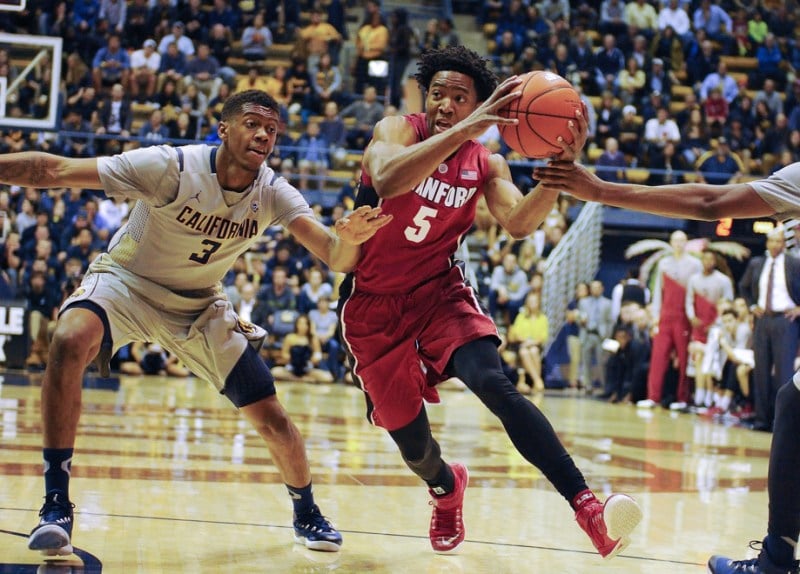Stanford men’s basketball rebounded from a narrow loss to Arizona on Thursday to dismantle Arizona State on Saturday (keep in mind that ASU had just beaten Cal 79-44). Stanford has yet to lose back-to-back games this season and has won its last eight games following a loss, dating back to last March. What is it that the team does differently in the game after a loss? Is there a pattern? What was the game-changer between the win over ASU and the loss to Arizona?
Irving: Outside the NCAA tournament, you don’t play back-to-backs against two quality opponents very often. You hit a losing skid when you don’t play great basketball and you fail to make adjustments after games. Last March, the Cardinal lost three in a row against ASU, No. 3 Arizona and Colorado because they were consistently subpar, especially on offense. Dwight Powell and Josh Huestis traded off between playing well, and the Cardinal shot a paltry 40.8 percent from the field (effective FG% of 44.3 percent) in their losing streak.
In their next three games, they shot 49.3 percent, with an eFG of 55.3 percent. The offense looked much sharper in the Pac-12 tournament, and Stanford rode its hot hand to a Sweet 16 run in March Madness.
If you ask why, the answer is Johnny Dawkins. In the last year, he’s done an exceptional job of identifying and correcting the team’s weaknesses after a loss. No one wants to lose, but losses are valuable because they reveal flaws. Against Arizona, a handful of bad rotations on defense in the second half cost the Cardinal the game. That’s what happens against good teams in tight games: Play poorly for three or four possessions, and they’ll snatch the game from you. In his postgame interview against ASU, Dawkins said he emphasized execution at practice on Friday following the disappointing loss. As a result, the team went out on Saturday night and showed just how dynamic it can be when it executes for all 40 minutes.
Furthermore, Dawkins has built a mesmerizing offense, and the players believe in his system. Consistency comes easily and consecutive losses become all the more uncommon. The Cardinal lost two of their best four players to the NBA, yet they’re sitting one game behind Utah and Arizona, two of the top 10 teams in the country, for first place in the Pac-12.
Yes, this Stanford team is good at basketball. Johnny Dawkins has elevated its play with his coaching, and winning is once again expected every game for the Cardinal.
Elizabeth: The matchup between Stanford and Arizona, the Pac-12 champion, was no blowout, as the score was neck-and-neck throughout the entire game. Although Stanford outshot Arizona, the Card lacked fluidity that could have secured them the W. It was not so much that Arizona is a better basketball team than Stanford, but more so in the second half, Stanford’s offense lost the flow, and that ultimately cost them the game. The issue with which Stanford grapples whenever it faces a loss is finding the magic touch and capitalizing on its opportunities. In the contest between Stanford and Arizona State, the Card’s offense could not be stopped, as it truly went to work. Always trying to better itself after a win or a loss by identifying and subsequently rectifying their mistakes, the team understands that practice is essential.
This year in particular, Chasson Randle has become Stanford’s men’s basketball’s go-to because he is an all-around good player. In the running for Pac-12 player of the year, Randle leaves everything out on the court. Although the team is chiefly comprised of veterans such as Randle, Anthony Brown and Stefan Nastic, the up-and-coming freshmen have also showcased good efforts in transitioning to collegiate basketball, reinforcing an already-strong foundation. This season, with all the talent and hard work that the team puts in, Stanford has the capability to make it far.
Andrew: Perhaps the most elegant explanation for Stanford’s ability to bounce back this season is one that Cardinal fans seem to almost automatically write off as an explanation for our team’s success these days: Stanford is actually very good this year! Johnny Dawkins has assembled a veteran squad that quite honestly should not have difficulty taking care of business against opponents like Arizona State or USC, regardless of who it has played a few days prior. Additionally, this strength has meant that Stanford simply has amassed more wins at this point in the season than it has in previous years, and when a team wins more games, it is less likely that it’ll have periods of consecutive losses. That’s just math.
Dawkins deserves some extra praise for this trend in that he always seems to get the team to play tough. Part of the heartbreaking nature of watching Stanford’s losses in recent years has been that the team truly has given its all in the face of stronger opponents, often building early leads and never quitting until the final buzzer sounds. This year, Stanford finally has the quality to come out on top of most of these tough games, and as a result the “lows” of Stanford basketball now seem a lot more manageable.
Contact Irving Rodriguez at irodriguez ‘at’ stanford.edu, Elizabeth Trinh at entrinh ‘at’ stanford.edu and Andrew Mather at amather ‘at’ stanford.edu.
